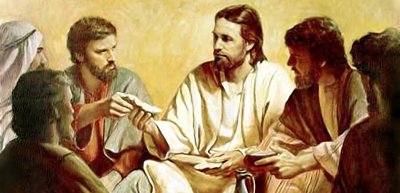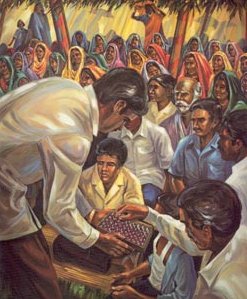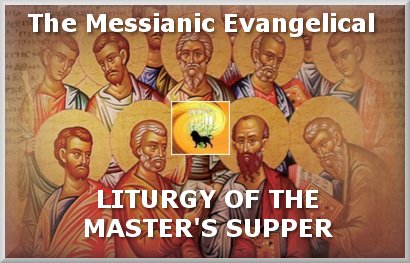
The 'Master's (Lord's) Supper' (in Hebrew, se'udat-haAdon), also known as 'Communion' and the 'Eucharist' (though neither of the latter two are biblical terms), was originally a rite or ordinance tagged onto the end of the annual Pesach or Passover Meal by Yah'shua (Jesus) which He commanded His talmidim (disciples) to celebrate (see the Messianic Evangelical Haggadah) in perpetuity in His honour until He should return.
Catholics, Eastern Orthodox Christians, Protestants and others celebrate various liturgised versions of the 'add on' ordinance on either a weekly or monthly basis whereas most Messianics observe the full Pesach (Passover) Meal plus the add-on once a year only. Considerable debate exists over these orthodox and messianic positions.
Messianic Evangelicals initially followed the Baptist tradition (though using non-alcoholic wine). Upon becoming Torah-compliant in 1999, and in common with a minority of messianics, Messianic Evangelicals started to observe both the annual Pesach (Passover) Feast (minus all the rabbinical additions) in the spring (on Aviv 14) and, like many Evangelicals, the weekly (maximum) "communion of the blood of Messiah" (1 Cor.10:16, NKJV) but on the Creation Calendar Sabbath rather than on 'Saturday' or 'Sunday'.
A clear distinction is made between the Master's Supper and what the New Testament calls 'the breaking of bread' or 'fellowship meals'. For the most part, the 'breaking of bread' simply means having a fellowship breakfast, lunch or supper with fellow believers, and the absence of sharing any 'cup' further confirms that this was not a sacrament. The expression 'breaking-bread' derives from a familiar Judahite (Jewish) custom of literally breaking a loaf of bread in two or more parts at the beginning of a common meal.
Paul has been falsely accused by some messianics of innovating a new custom or rite like the one we call 'Communion' or the 'Eucharist' today. There is no historical evidence that he did - had that been the case, it would have caused considerable division and friction between Judahite and 'Gentile' congregations. More likely, the Messianic Community's 'Master's (Lord's) Supper' may simply have been called the Ahavah, Agapé or "Love Feast" that is mentioned in Corinthians (1 Cor.11:16-17). The practice in the Corinthian Assembly was to share a common meal first, followed by the solemn rite of the Master's Supper, something that Paul objected to, insisting they be kept separate, on account of a number of abuses (1 Cor.11:22,30-34).
According to Paul, the Master's Supper is anchored firmly in Yahweh's redeeming purpose so that the rite proclaims Yah'shua's (Jesus's) death (1 Cor.11:26) in the same way the Pesach (Passover) rite sets forth the redeeming mercy of Yahweh, hence its name, the Haggadah (in Hebrew) or Katangellein (in Greek). The apostle also explains the inner meaning of the Table as a communion or fellowship (koinonia) with the Master in His death and risen life, signified in the bread and wine (1 Cor.10:16). Within this is to be found the dynamic unity or echadness of the Messianic Community (Church) as a whole, for as the members share together the one loaf they sit down as the one Body of Messiah, sharing not only Yah'shua's (Jesus') body but the "bread of affliction" (Dt.16:3) that persecution and tyranny in the world. The link between Pesach (Passover) and the Master's Supper becomes obvious. There are also eschatological overtones with the forward look to the advent in glory.

Summarising, Adolf Schlatter could thus write:
"[Paul] can express the word of Yah'shua (Jesus), not in half measure, but completely, without mentioning the sacraments at all. But if they come into view he connects with them the entire riches of the grace of Messiah (Christ), because he sees in them the will of Yah'shua (Jesus), not partially but fully expressed and effective" (Die Briefe an die Thessalonischer, Philipper, Timotheus und Titus: 1952, p.262).
There are Master's Supper allusions in Hebrews 6:10; 13:10 and the Gospel of John which relates to a later messianic eucharistic tradition (Jn.6:22-59). There is also the witness of 2 Peter 2:13 and Jude 17 to the Ahavah/Agapé Meal. It is not until the post-apostolic era that we gain a clearer picture of what the early liturgy of the master's Supper consisted, and in particular from Clement (1 Clem.40:2-4), Ignatius (Smyr.8:1) and the Didache.
The Messianic Evangelical Liturgy of the Master's Supper is based on an adaptation of the Didache or 'Teaching', otherwise known as 'The Teaching of the Master to the Gentiles, Through the Twelve Apostles' (Section II, Part 3), 'Of the Eucharist'. The Didache was the equivalent of the Messianic Evangelical Constitution of the Assemblies of Yahweh in Syria in AD 150. The Messianic Evangelical adaptation is based on an original revelation received on 4 February 2001 which has passed through several editions over the years. This symbolic Master's Supper (as opposed to the literal Johannine Communion) is administered every Sabbath, except at Pesach (Passover), to all baptised and chrismated members in good standing who desire it.

| Inner Reality/ Decision(s) |
Outward Ordinance/ Action(s) |
Corresponding to festival of |
| Decision for Messiah (Alef) |
Dedication Covenant |
Pesach |
| Repenting of sins |
Catechumen Covenant |
Chag haMatzah |
| Born again, spiritual regeneration |
Baptism by immersion (at 8 years of age or older) into Messiah & Messianic Israel |
Yom haBikkurim |
| Full membership (Mem) |
Bar/Bat-Mitzvah Covenant to obey Torah (renewed annually) = Chrism or Confirmation (at 12 years of age or older), Master's Supper & Betrothal after a minimum of one year's probation following baptism |
Shavu'ot |
| Priesthood calling |
Interview with Chavurat Bekorot |
Yom Teruah |
| Priesthood commitment |
Training, Ordination (at 30 years of age or older), Annual Weighing & Covenant renewal |
Yom haKippurim |
| From Servant to Friend (Taw) |
Full HEM (Holy Echad Marriage) & eligibility to fully enter Holy Order |
Sukkot |
|


